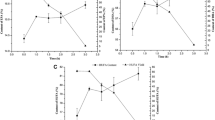Abstract
Purification of docosahexaenoic acid (DHA) was attempted by a two-step enzymatic method that consisted of hydrolysis of tuna oil and selective esterification of the resulting free fatty acids (FFA). When more than 60% of tuna oil was hydrolyzed with Pseudomonas sp. lipase (Lipase-AK), the DHA content in the FFA fraction coincided with its content in the original tuna oil. This lipase showed stronger activity on the DHA ester than on the eicosapentaenoic acid ester and was suitable for preparation of FFA rich in DHA. When a mixture of 2.5 g tuna oil, 2.5 g water, and 500 units (U) of Lipase-AK per 1 g of the reaction mixture was stirred at 40°C for 48 h, 83% of DHA in tuna oil was recovered in the FFA fraction at 79% hydrolysis. These fatty acids were named tuna-FFA-Ps. Selective esterification was then conducted at 30°C for 20 h by stirring a mixture of 4.0 g of tuna-FFA-Ps/lauryl alcohol (1:2, mol/mol), 1.0 g water, and 1,000 U of Rhizopus delemar lipase. As a result, the DHA content in the unesterified FFA fraction could be raised from 24 to 72 wt% in an 83% yield. To elevate the DHA content further, the FFA were extracted from the reaction mixture with n-hexane and esterified again under the same conditions. The DHA content was raised to 91 wt% in 88% yield by the repeated esterification. Because selective esterification of fatty acids with lauryl alcohol proceeded most efficiently in a mixture that contained 20% water, simultaneous reactions during the esterification were analyzed qualitatively. The fatty acid lauryl esters (L-FA) generated by the esterification were not hydrolyzed. In addition, L-FA were acidolyzed with linoleic acid, but not with DHA. These results suggest that lauryl DHA was generated only by esterification.
Similar content being viewed by others
References
Fischer, S., Dietary Polyunsaturated Fatty Acids and Eicosanoid Formation in Humans, in Advances in Lipid Research, edited by R. Paoletti and D. Kritchevsky, Academic Press, New York, 1989, Vol. 23, pp. 169–198.
Harris, W.S., Fish Oils and Plasma Lipid and Lipoprotein Metabolism in Humans: A Critical Review. J. Lipid Res. 30:785–809 (1989).
Yamaguchi, M., I. Tanaka, and Y. Ohtsu, New Method for Separation and Purification of Polyunsaturated Fatty Acids Using a Silver Ion-Exchanged Spherical Clay Mineral, Yukagaku (in Japanese) 40:959–964 (1991).
Shimada, Y., A. Sugihara, K. Maruyama, T. Nagao, S. Nakayama, H. Nakano, and Y. Tominaga, Enrichment of Arachidonic Acid: Selective Hydrolysis of a Single-Cell Oil from Mortierella with Candida cylindracea Lipase, J. Am. Oil Chem. Soc. 72:1323–1327 (1995).
Shimada, Y., A. Sugihara, H. Nakano, T. Nagao, M. Suenaga, S. Nakai, and Y. Tominaga, Fatty Acid Specificity of Rhizopus delemar Lipase in Acidolysis. J. Ferment. Bioeng. 83:321–327 (1997).
Yang, L.Y., A. Kuksis, and J.J. Myher, Lipolysis of Menhaden Oil Triacylglycerols and the Corresponding Fatty Acid Alkyl Esters by Pancreatic Lipase in vitro: A Reexamination, J. Lipid Res. 31:137–148 (1990).
Shimada, Y., K. Maruyama, S. Okazaki, M. Nakayama, A. Sugihara, and Y. Tominaga, Enrichment of Polyunsaturated Fatty Acids with Geotrichum candidum Lipase, J. Am. Oil Chem. Soc. 71:951–954 (1994).
Shimada, Y., K. Maruyama, M. Nakamura, S. Nakayama, A. Sugihara, and Y. Tominaga, Selective Hydrolysis of Polyunsaturated Fatty Acid-Containing Oil with Geotrichum candidum Lipase, Ibid.:1577–1581 (1995).
Hoshino, T., T. Yamane, and S. Shimizu, Selective Hydrolysis of Fish Oil by Lipase to Concentrate n-3 Polyunsaturated Fatty Acids, Agric. Biol. Chem. 54:1459–1467 (1990).
Syed Rahmatullah, M.S.K., V.K.S. Shukla, and K.D. Mukherjee, Enrichment of γ-Linolenic Acid from Evening Primrose Oil and Borage Oil via Lipase-Catalyzed Hydrolysis, J. Am. Oil Chem. Soc. 71:569–573 (1994).
Hills, M.J., I. Kiewitt, and K.D. Mukherjee, Enzyme Fractionation of Fatty Acids: Enrichment of γ-Linolenic Acid and Docosahexaenoic Acid by Selective Esterification Catalyzed by Lipases, Ibid.:561–564 (1990).
Syed Rahmatullah, M.S.K., V.K.S. Shukla, and K.D. Mukherjee, γ-Linolenic Acid Concentrates from Borage and Evening Primrose Oil Fatty Acids via Lipase-Catalyzed Esterification, Ibid.:563–567 (1994).
Foglia, T.A., and P.E. Sonnet, Fatty Acid Selectivity of Lipases: γ-Linolenic Acid from Borage Oil, Ibid.:417–420 (1995).
Shimada, Y., A. Sugihara, H. Nakano, T. Kuramoto, T. Nagao, M. Gemba, and Y. Tominaga, Purification of Docosahexaenoic Acid by Selective Esterification of Fatty Acids from Tuna Oil with Rhizopus delemar Lipase, Ibid.:97–101 (1997).
Sugihara, A., Y. Shimada, and Y. Tominaga, Separation and Characterization of Two Molecular Forms of Geotrichum candidum Lipase, J. Biochem. 107:426–430 (1990).
Maruyama, K., and M. Nishikawa, Function of Fish Oil and Its Application to Foods, Food Chemicals (in Japanese) 1995- 4:31–37 (1995).
Author information
Authors and Affiliations
Corresponding author
About this article
Cite this article
Shimada, Y., Maruyama, K., Sugihara, A. et al. Purification of docosahexaenoic acid from tuna oil by a two-step enzymatic method: Hydrolysis and selective esterification. J Amer Oil Chem Soc 74, 1441–1446 (1997). https://doi.org/10.1007/s11746-997-0251-5
Received:
Accepted:
Issue Date:
DOI: https://doi.org/10.1007/s11746-997-0251-5




